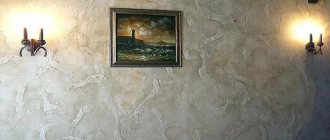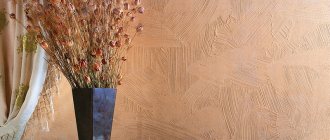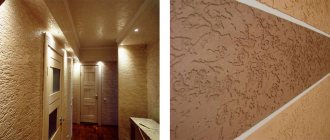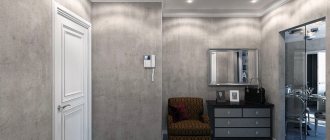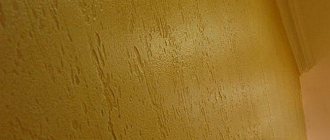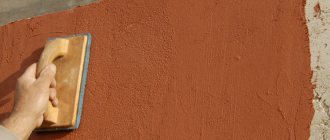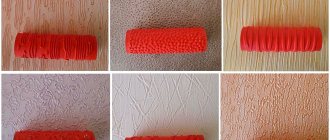Is it possible to paint decorative items and with what paint?
To work with the plaster mixture, white paint is often purchased. You can add any pigments to it in the required quantity.
Moroccan and Venetian varieties of decorative items do not need painting. The pigment must be applied to a textured surface. To save time, many craftsmen add color to the plaster. This mixture also does not require additional coloring after application.
There is no clear answer to the question of whether decorative plaster can be applied to paint. It all depends on the components in the material. However, before you start decorating the wall, it is advisable to clean it.
Tinting process
Obtaining a finished painted surface is carried out independently, for which purpose the façade plaster is tinted according to the following instructions:
- The facade is cleaned of construction debris with a rag or vacuum cleaner;
- The base is treated with a primer until completely dry;
- Color is applied. The event is carried out in small areas using an ordinary brush. The entire façade is treated with a roller. The brush is moved vertically and horizontally so that the mixture fills all the pores;
- The composition is applied with a roller in vertical stripes from bottom to top. To avoid gaps, each subsequent strip is made with an overlap on the previous one.
To plaster the facade in a monochromatic light, you need a roller and a round brush. To obtain a high-quality, distributed color, the façade plaster should be applied 2–3 strokes each. To ensure complete penetration of the color into the recesses of the textured plaster, it is applied with strong pressure on the roller.
Tinting facade plaster is the most important stage of work, which serves the aesthetic perception of the structure. Depending on the type of surface, different shades are used. The choice in favor of a specific color depends on the material, as well as its ability to transform the applied finish into the required color. The advantage of tinting is the fact that you can do this process yourself.
Decorative paint - what to paint (which is better to choose)
The choice of composition depends on the place of its use. Silicate, silicone and acrylic facade paints are suitable for exterior work. They protect the plaster from the effects of the external environment: temperature changes, rain, wind, etc.
The following types of paints are used for interior work:
- Latex
. Such compositions are characterized by low cost. Their main disadvantage is considered to be fragility. Latex paints do not tolerate temperature changes.
- Water-based
. The compositions are used if you need to create a matte rather than glossy finish. The disadvantages include the need to apply paint in 2 layers, which leads to additional costs.
- Acrylic
. The paints are suitable for use in northern regions. They practically do not react to low temperatures. The compositions can be special, glossy and glyphthalic. The latter variety is used more often than others due to the content of acrylic resins that improve the properties of paints.
Compositions based on latex and water-based dispersion protect walls from the formation of mold and fungi that are dangerous to human health.
All types of paints are suitable for both smooth and textured surfaces. However, when covering relief walls, the material consumption is 1.5-2 times higher.
The easiest way to add color to plaster
Since the decorative material initially most often comes only in white, the craftsmen add color to it when mixing the solution. This is a very simple method and helps to obtain a one-color mass. The color and plaster are mixed using a construction mixer; this is a special attachment that helps not only mix everything thoroughly, but also maintain the structure of the coating intact.
This method is used when Venetian is applied, or a single-color coating or a single-color base is required. For tinting, only water-based dyes are used. If you take a concentrated color, then no more than 10% can be added to the mixture, otherwise the structure of the coating will change its characteristics not for the better. One important rule should be remembered: the tinted decorative material must be constantly stirred, because the pigment can settle and the color will be uneven.
Tinted plaster is the latest and currently very popular material, which is used both for the facades of buildings and for finishing interiors. Tinted plaster is a type of modern material that can significantly simplify finishing work, reduce the time spent on it, and the quality of such a coating and its durability are very high. Tinted plaster is a ready-made decorative plaster, which is made in any color directly during the manufacturing process at the request of the customer. This type of plaster allows you to reduce the number of works, which will save time and effort, as well as money for performing these works. For example, the need for painting work is completely eliminated. Decorative plaster is delivered to you already painted in the color you need. There is also no need not only to paint the walls, but also to pre-prime the paint. You will not need to spend money not only on paint, primer, masking tape required for covering some areas to protect against paint, but also various tools for painting work, such as brushes, gloves, rollers, paint solvents for cleaning working tools and others.
An important property of tinted plaster is its increased resistance to aggressive external factors. That is why it is also used for external finishing work on the facade of the house, because tinted plaster is able to retain its original color even with any scratches, when exposed to wind, snow and rain. The reason for this is that tinted plaster is painted with one color over the entire thickness of the applied layer. Normally, with prolonged aggressive exposure to rain, hail, wind or due to various scratches, it can weaken and expose a layer of plaster of a different color on the damaged area.
If the walls in the room are decorated with tinted plaster, then repairs in this room will not have to be done soon: such a finish is unusually durable and non-staining, any damage to such a decorative layer does not attract the eye, and the walls look excellent for a very long time. However, of course, tinted plaster will serve you longer if you take at least minimal care about the safety of the coating. You should be careful when transporting and rearranging furniture, do not scratch the plaster with anything, and, if possible, protect the walls from the play of animals and small children.
Tinted plaster is a fairly universal coating that will fit into any interior, suitable for any room in an apartment or house, and will allow you to implement a variety of design ideas. Also, tinted plaster will help you significantly save your time and effort spent on repairs, and will provide freedom in choosing the color of the walls and the place of decoration - from any of the rooms to the facade of the house.
Tinting textured plaster with decorative paints
Since the plaster is white or light gray in color, it is often tinted during renovation work. This technique allows you to make small chips and cracks invisible.
Several pigments are often used for tinting. It is advisable to select dyes at a hardware store. Using a special program will allow you to find beautiful color combinations. At home, pigments are mixed using a mixer. It is advisable to do a test paint. It should be noted that after drying, the plaster solution becomes lighter by 1-2, and sometimes more shades. For this reason, you need to add more pigment.
Tools for working with decorative paint
The choice of tools depends on the technique.
In most cases, masters use:
- plaster mixture (can be replaced with putty);
- paints and colors;
- foam sponges;
- brushes with different bristles;
- mixer;
- spray gun (for working with a large area);
- pieces of fabric;
- trays for varnish, paints and other compounds;
- masking tape (to highlight work areas);
- stepladder (when painting indoor walls);
- scaffolding (for working with facades).
You can use textured paint as decorative plaster. Sequins and other decorative elements are also additionally used.
Design using abstract pattern technique
Next, let's see how to paint decorative plaster using this chaotic method. To finish the walls in this way, the home craftsman will need to make his own special tool - a roller with a “torn” surface. To do this, you just need to take a regular roller and secure the tissue flagella folded several times along its entire length. Such elements need to be secured with fur or foam rubber using two simple knots. The strips of fabric on the working part of the roller should be held as firmly as possible.
By painting a wall with such a tool, you can get a very unusual chaotic pattern. In addition to the fact that the surfaces in this case turn out to be unusual and original, the work can be done very quickly when using a torn roller.
Preparing the surface for painting
The walls must be cleaned of dust and pellets remaining as a result of applying the plaster mixture. For smooth surfaces, use a clean cloth. For relief walls, a dampened sponge is suitable. You can also use a vacuum cleaner. Then a primer is applied to the wall.
This needs to be done in order to:
- improve adhesion of plaster and paint;
- fill small cracks in the coating;
- prevent spreading of the plaster layer.
Before you start painting, you need to protect the floor, window sill and other surfaces.
Advantages and disadvantages of various staining methods
Each painting method is a way to implement a specific design idea. If we take the “dry brush” and “blur” techniques for comparison, then the second method is more complex in execution and is more time-consuming and physical.
To implement it, a layer of paint with a darker shade is applied to the main background of the surface, which dries for a certain time, after which the top layer is wiped off the convexities of the plaster with a damp cloth. As a result, dark paint remains only in the depressions and a three-dimensional pattern is created.
Complex effects are obtained by using several different paints.
How to paint decorative items with your own hands
Beginners should strictly adhere to ready-made technologies. However, people who know how to paint decorative plaster with their own hands often combine several methods of applying pigment.
Painting walls one color over textured plaster
This method is considered the simplest. It is suitable for inexperienced craftsmen. The paint is applied to the surface in ribbons up to 6 cm wide. The strokes must be vertical. Excess paint must be shaded. If the surface is embossed, the strokes can be horizontal.
Painting decorative items in two colors (mother-of-pearl)
This technique is more often used in cases where it is necessary to lighten/darken depressions or relief parts of the wall. When painting decorative plaster in two colors, it is recommended to use mother-of-pearl as a complement to the main shade.
There are several options for working:
- If there are many depressions in the surface, you can apply additional color first. To do this, use a long-haired roller. After the first layer has dried, you need to apply the main color. It is advisable to use a sponge.
- A smooth surface should be painted in the main shade. You can use a spray gun or a wide brush. After drying, apply additional color with a figured roller.
- When it is necessary to emphasize protruding parts, the wall must be painted in the main tone. Additional color is applied to the bumps using a sponge or narrow brush.
DIY dry brush paint technique for walls
The technique is used to enhance texture. The result of the work is to paint the recesses in darker tones. White paint is mixed with the desired color. The shade should be bright. A long-haired roller is suitable for application. The surface must be completely dry.
For the second layer, apply the same color as for the first. However, a smaller amount of pigment is added to white paint to make the shade 2-3 shades lighter. The layer must be applied with a brush to the protruding parts. You can use a short nap roller.
Before applying the second layer, wipe the brush with a cloth or paper. This way there is a minimal amount of dye on the instrument. When applying the second layer, you can use pearlescent or metallic powder.
This technique is similar to the method of working with 2 colors. The difference is that the master does not wait for the decorative plaster to dry; painting begins immediately.
Removing paint to brighten interior walls
The technique is used only for working with relief surfaces. The task is to highlight the depressions. To achieve the result with the least amount of time and effort, textured plaster is painted in one color. After 1-2 days, all protruding fragments are removed using a grinding machine, which creates a worn effect and ages the surface.
There is a more labor-intensive method of highlighting, which includes the following steps:
- Application of the main color. It is necessary to treat a small area of the wall with water-based paint.
- Surface cleaning. The paint must be wiped off with a damp foam sponge. The color will only remain in the recesses.
- Applying additional tone. This step is optional. Relief areas are painted with a sponge or thin brush in a shade lighter or darker than the main color.
- Applying a fixative.
Venetian plaster effect on the wall
Using putty, you can imitate natural stone - malachite, granite, etc. This technique is called the Venetian plaster effect. Stone chips are sometimes used to create it. But, since this is an expensive material, it is often replaced with gypsum plaster, painted in the required color.
The technology has the following stages:
- Preparing the coating for work. This stage includes cleaning and removing minor defects.
- Applying the base layer. A long-haired roller is suitable for the job. Additionally, you may need a narrow brush, which is used in hard-to-reach places. You need to wait until it dries.
- Application of decorative coating (gilding, bronze). Inexpensive aluminum powder is often used to create a “silver” tint. The decorative layer can be applied with a short-bristled brush or foam roller. The touch should be light and the pressure should be insignificant. If the technique is followed, the first layer will be visible from under the second.
- Consolidation. At the final stage, a water-based varnish is applied to the coating. Since this substance can create a crust, it must be diluted. Water should make up no more than 20-30% of the total volume. The varnish should be applied with a foam roller.
Marble wall
The method is used for both smooth and textured surfaces. It can be used to imitate marble. Gray color is added to white paint, and then it is applied to the work surface. A roller is used for this. You can use the dry brush method. Part of the surface should remain completely or partially unpainted.
A smaller amount of pigment is added to the composition for the second layer. It is advisable to use a different roller for the job. You can cover not only unpainted areas of the surface, but also those places to which a darker shade has already been applied. It is permissible to start work before the base layer dries.
After 2-3 days, the veins characteristic of marble are painted with a thin brush. The surface is coated with acrylic varnish or made matte if it is necessary to create the effect of unpolished stone.
Using fabric
A pigment of the desired color is added to water-based paint. The finished mixture is applied with a brush or long-haired roller. A piece of fabric measuring at least 30x30 cm is moistened with cool water and wrung out. Then it must be crumpled and attached to the roller. This must be done before the paint dries. Shading is done with a soft brush with long bristles.
After the first layer has dried, you can begin applying the second using the indicated technique. In order for the “stone” to have a natural look, you should change the shade, making it darker or lighter.
You can add a small amount of mother-of-pearl to the paint for the second layer. During one session, it is recommended to work with a section of the wall whose area does not exceed 3 square meters. m.
Benefits of painting plaster
The plaster material used for finishing has a number of positive properties. Experts highlight the following advantages of its choice:
- Painting textured plaster helps to obtain a unique coating; each application adds its own images due to technology, so each finish will be unique;
- Some types of mixtures can cover surface defects; we are talking about minor defects; if the defects are serious, they are treated in advance with special mixtures;
- Noise and heat insulation effect;
- Eco-friendly composition, the components are only elements that are safe for humans and nature;
- A variety of coating options. Methods for applying the solution can be different; the only limitation is the imagination of the master; improvised materials and special rollers and stencils can be used. This helps to realize any design ideas.
Painting textured plaster helps create a unique finish.
How to repaint decorative material
Before repainting decorative plaster a different color, it is not necessary to clean it of the previous shade. If it is not possible to remove the old layer, it is permissible to apply a white acrylic-based primer. The texture is preserved. After drying, you can start painting. In some cases, no primer is used. For example, if you need to lighten Venetian plaster, it is enough to cover it with a layer of pearlescent glaze.
How to remove old decorative material
Experts advise removing the old layer of putty. To do this, it must be moistened with warm water and left for 1.5-2 hours. You can use a steam generator. Then the old layer is removed using abrasive materials. The walls must be dry before further work.
Choosing a dye
In some cases, it is more advisable not to paint the plastered surface, but to apply decorative plaster with an already selected shade. To do this, pigment dye is added directly to the plaster mixture.
The color pigment is added separately to the plaster dye.
Tinting must be done on the entire composition at once - otherwise it will be difficult to select the same shade for re-preparing the composition. For example, for cement plaster you can use any concrete dye, but for a polymer mixture it is recommended to use an acrylic-based color.
A simple way is to add a universal dye to the plaster mixture.
When purchasing dyes for plaster, it is recommended to pay attention to the packaging labeling, which will indicate what kind of work the color is intended for (interior or exterior decoration), what type of plaster (for concrete, polymer, gypsum, cement).
Pay attention to: How and how to remove acrylic paint
Wax on plaster
Wax compositions can be:
- Synthetic. This wax has water-repellent properties and is resistant to temperature changes. Synthetic wax can be applied with almost any tool.
- Gel-like. The compositions are applied with rubber spatulas.
- Liquid. Wax is used for any type of surface. It is advisable to apply it with a cloth.
Compositions including wax are used in the final stages of painting decorative plaster.
Their use helps:
- enhance color brightness;
- give a glossy shine;
- protect from moisture;
- deepen the relief surface;
- change the color of Moroccan or Venetian plaster walls.
You can add glitter (sparkles) or pigment to the wax. In this case, the composition must be constantly stirred to maintain its homogeneity. Within 3-4 hours after application, the wax layer can be corrected.
Tinted plaster - two in one
Tinted plaster is one of the newest materials in the field of finishing both building facades and interior work.
The production of modern building materials does not stand still and work is constantly underway to ensure high cost reduction of various materials and ensure minimal costs during the production of work. In addition, some new building materials make it possible to significantly reduce the time required to complete work and even eliminate some types of work, while ensuring high quality, durability and excellent consumer properties of objects in the construction of which the latest finishing materials are used.
An example of one such material is Limex tinted plaster, the quality of which and ease of use are appreciated by many construction organizations and private developers. Tinted plaster is a ready-made decorative plaster that, already during the production process, is made in the color at the request of the customer. Using tinted plaster allows you not only to save money when performing work, but also to eliminate some of the work, which also saves time. Finishing the walls with tinted decorative plaster allows you to avoid such tasks as painting. Since the decorative plaster is already painted in the color you need, you do not need to do work such as priming before painting and the actual painting itself. You save significant money because you do not need to buy primer, paint, masking tape, which is used to cover some elements to avoid paint getting in, as well as brushes, rollers, gloves and solvents for cleaning tools after painting. With the money saved, you can purchase a lot of different things for repairs or decoration, and in special cases, a gift for your beloved mother-in-law.
It should also be noted that tinted plaster is much more resistant to external factors and retains its color regardless of the depth of scratches or the strength of wind and rain, since it is completely painted in one color throughout the entire thickness of the layer. In addition, aggressive factors such as rain, hail, and strong wind can, over a long period of time, damage the paint layer and the lower layer of plaster of a different color will be visible on the damaged area of the coating. In rooms where the walls are finished with tinted decorative plaster, minor damage to the decorative layer is not noticeable and allows you to go without repairs for a long time. Damage can occur during transportation of furniture, accidental damage to parts of the interior, as well as in the presence of small children and heavy toys, dogs and cats, well, let’s hide it, they also sometimes test the strength of the finishing of our homes.
Like all other building materials of the LIMEX
, tinted plasters of this brand are received only by positive professional builders who have been successfully using Limex tinted plasters for quite a long time, as well as various other paints and varnishes, fungicides, varnishes, and decorative paints for surfaces.
Paints and varnishes and finishing materials of the Limex brand are among the highest quality materials among domestic manufacturers, which is facilitated by modern production, highly trained specialists and strict quality control of both raw materials and the finished product. All products undergo serious testing to ensure compliance with all requirements of both domestic and foreign quality standards. Year after year, there are more and more professional builders and individuals who are happy to use Limex materials and receive excellent results and high quality that meet the most modern requirements.
A variety of surface textures, manufacturability of the process, plasticity, durability and safety of the finished coating are the distinctive qualities of San Marco finishing materials.
To apply the color composition immediately, at the stage of preparing the mixture, it is tinted. Some types of mixtures do not require dyeing in the mass. In such cases, they are painted after applying a variety of interior or facade paints to the surface. In addition to painting the white surface, some areas are tinted to create certain design effects.
Glaze
The glazing composition (glaze) can be applied to both textured and smooth surfaces. It is used for both internal and external work.
Using glaze has a number of disadvantages:
- It is necessary to shade the joints immediately after applying the glazing composition.
- Surfaces should be covered with the material in small strokes. For this reason, working with compositions takes a lot of time.
- Before applying the composition, you need to wear special gloves. If a person feels dizzy or suffocated, respiratory protection may be necessary.
- You can work with the compositions at a temperature not lower than 10ºС.
Expert advice
To achieve maximum results, it does not hurt to take into account the recommendations of professional finishers. In particular, these tips may help:
- Painting must be done at a temperature not lower than +5 °C.
- Before the coating sets, you must avoid contact with the sun's rays and moisture on the treated surface.
- If acrylic or water-based paint has thickened, it is diluted with water to the desired consistency.
- Usually the color of the paint in the container is brighter than on the wall after drying. Therefore, it is worth carrying out a test painting on a small and inconspicuous area.
- to start painting plaster
from hard-to-reach areas (for example, corners). - In cases where the surface is painted with two different colors, it is advisable to mark the border with masking tape to avoid contamination of the wall.
If the dyeing technology is followed, the treated surface gets an attractive appearance. The walls not only look beautiful, but are also reliably protected from external interaction, and also serve for a long time.
With the help of decorative plaster and a palette of colors, creating a unique wall design turns into a creative process
The considered methods of applying a coloring composition to decorative plaster can be used separately, choosing the appropriate option, or combining several techniques. In the latter case, it is possible to create a new effect, which will emphasize originality. Minor deviations from technology will not cause harm, as will the use of your own imagination.
Did you learn something new? Share in the comments!
Varnish
The material protects against moisture and mechanical damage. It is used when you want to add shine to a matte surface. When finishing premises, acrylic water-soluble varnishes are used. Craquelure varnish is suitable for creating artificial cracks. When working with facades, compositions based on organic solvents are used.
Before use, you can add dyes of the desired color or glitter to the varnish. After thorough mixing, apply the coating in 1 layer with a foam roller, sponge or brush.
Structural plaster: features
This type has a heterogeneous granular composition, which includes additives in the form of granules or fine-grained pebbles, as well as pieces of quartz. This finish is made on a cement-lime base using a special synthetic latex. It is also diluted with water or organic solvents.
For plastering inside a building, the most suitable option is water-based mixtures. They do not contain foreign impurities with a smell, which means that when finishing the apartment there is no need to remove all residents from it.
The main advantage of structural plaster is its plasticity, which makes it very easy to work with. The work is simplified due to the fact that the solutions are already sold ready-made and no special preparation is required before use. It goes on sale in iron containers or buckets weighing 15-25 kg.
Return to contents

